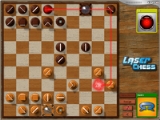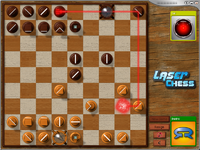
Laser Chess
Encyclopedia
Laser Chess first appeared in Compute!'s Atari ST Disk & Magazine in 1987, written in Modula-2
. It won the $5,000 first prize in a programming competition held by the magazine. Ports of the game written in BASIC and machine language were published in the June 1987 issue of COMPUTE!
Magazine for the Commodore Amiga, Commodore 64
, Apple II
, Atari XL and Atari XE.
Laser Chess has been re-implemented many times over the intervening years, including a variant Advanced Laser Chess with a larger board and additional pieces.
-like pieces, most of which have mirrored surfaces, and one of which is a laser
cannon. The game somewhat resembles Deflektor
by Gremlin Graphics especially in the presence of the laser game mechanic.
Players take alternate turns taking two actions with their pieces. An action consists of moving a piece vertically or laterally, rotating a piece 90 degrees, or "firing" the laser cannon. A teleporter
piece can teleport pieces that it lands on.
Moving a distance of one square takes one move; moving two squares takes two moves. Since a player has only two moves per turn, the maximum distance a piece can be moved on one turn is two squares. Pieces can be moved forward, backward, left, or right, but not diagonally. However, a player can effectively move a piece diagonally by using two moves—forward and right, for example.

The laser will bounce off any mirrored piece, so both a player's own and the opponent's pieces may be used to set up a shot. Since a player is focused on creating a path from that player's laser cannon to a target of interest, the player must be aware that he or she is also creating a path to his or her laser at the same time.
Modula-2
Modula-2 is a computer programming language designed and developed between 1977 and 1980 by Niklaus Wirth at ETH Zurich as a revision of Pascal to serve as the sole programming language for the operating system and application software for the personal workstation Lilith...
. It won the $5,000 first prize in a programming competition held by the magazine. Ports of the game written in BASIC and machine language were published in the June 1987 issue of COMPUTE!
COMPUTE!
Compute! was an American computer magazine that was published from 1979 to 1994, though it can trace its origin to 1978 in Len Lindsay's PET Gazette, one of the first magazines for the Commodore PET computer. In its 1980s heyday Compute! covered all major platforms, and several single-platform...
Magazine for the Commodore Amiga, Commodore 64
Commodore 64
The Commodore 64 is an 8-bit home computer introduced by Commodore International in January 1982.Volume production started in the spring of 1982, with machines being released on to the market in August at a price of US$595...
, Apple II
Apple II
The Apple II is an 8-bit home computer, one of the first highly successful mass-produced microcomputer products, designed primarily by Steve Wozniak, manufactured by Apple Computer and introduced in 1977...
, Atari XL and Atari XE.
Laser Chess has been re-implemented many times over the intervening years, including a variant Advanced Laser Chess with a larger board and additional pieces.
Description
Laser Chess is a two-player computer game, modeled as a board game with chessChess
Chess is a two-player board game played on a chessboard, a square-checkered board with 64 squares arranged in an eight-by-eight grid. It is one of the world's most popular games, played by millions of people worldwide at home, in clubs, online, by correspondence, and in tournaments.Each player...
-like pieces, most of which have mirrored surfaces, and one of which is a laser
Laser
A laser is a device that emits light through a process of optical amplification based on the stimulated emission of photons. The term "laser" originated as an acronym for Light Amplification by Stimulated Emission of Radiation...
cannon. The game somewhat resembles Deflektor
Deflektor
Deflektor is a puzzle game developed by Vortex Software and published by Gremlin Graphics in 1987. In this game, the player has to rotate mirrors to deflect a beam in order to destroy all the mines of each level. There are also other devices the player has to be careful not to touch with the beam...
by Gremlin Graphics especially in the presence of the laser game mechanic.
Players take alternate turns taking two actions with their pieces. An action consists of moving a piece vertically or laterally, rotating a piece 90 degrees, or "firing" the laser cannon. A teleporter
Teleportation
Teleportation is the fictional or imagined process by which matter is instantaneously transferred from one place to another.Teleportation may also refer to:*Quantum teleportation, a method of transmitting quantum data...
piece can teleport pieces that it lands on.
Moving a distance of one square takes one move; moving two squares takes two moves. Since a player has only two moves per turn, the maximum distance a piece can be moved on one turn is two squares. Pieces can be moved forward, backward, left, or right, but not diagonally. However, a player can effectively move a piece diagonally by using two moves—forward and right, for example.

Firing the laser
On a player's turn, the player can elect to fire the laser cannon. Firing the laser cannon takes only one move, but can be done only once per turn. Therefore, a player may want to use the first move in a turn to aim the laser, rotate a reflecting piece to set up a reflected shot, or move another piece into position. Laser beams are absorbed if they hit the edge of the board.The laser will bounce off any mirrored piece, so both a player's own and the opponent's pieces may be used to set up a shot. Since a player is focused on creating a path from that player's laser cannon to a target of interest, the player must be aware that he or she is also creating a path to his or her laser at the same time.
External links
- Laser Chess at TrayGames
- http://www.laserchess.org

